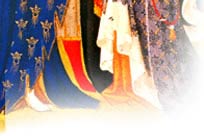 |
|||
 

|
Medieval History of Italy Italy's geographic position, as well as its importance as the seat of power during the Roman empire makes this country rich in medieval history. The Visigoths sacked Rome in 410 a.d. and brought an end to centuries of Roman rule throughout the world. But Italy was far from vanquished, and its rise continued through religious power, and its importance along trading routes. The succeeding centuries saw the development of many of Italy's most famous cities. Venice was founded in 811 by mainlanders escaping barbarian invaders. In 1060, the country's first university was founded in Bologna. Medieval Italy saw the birth of important literary works and became the cradle of Western art. In 1321. Dante Alighieri finished his La Divina Commedia (the Divine Comedy) which formed the basis of literature in modern Italian. Artistic revolution began early in the Middle Ages as artists rebelled against Byzantine ethics that art should only have religious connotations. Soon, landscapes, floral designs, and the everyday life of common people became focal points for new works. During the 13th century, Cimabue was one of the early pioneers to portray real people in real settings. Religious art wasn't abandoned, and some of the greatest medieval masterpieces continued to portray biblical scenes. 13th century Tuscany was the focal point for tremendous political and economic growth. Not to be outdone, other cities began constructing massive buildings out of civic pride. Cathedrals were built high and were full of light to elevate the soul. Medieval Italy was an intoxicating mix of ancient Roman architecture, rising theocratic power, and artistic rebellion that would lead to this country's foundation as the heart of the Renaissance. |
 |
|
 |
|||
 |
|||